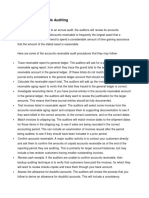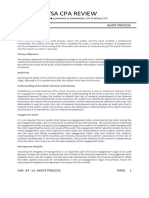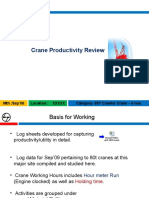AAA Assignment3
AAA Assignment3
Uploaded by
Hamza ZahidCopyright:
Available Formats
AAA Assignment3
AAA Assignment3
Uploaded by
Hamza ZahidOriginal Title
Copyright
Available Formats
Share this document
Did you find this document useful?
Is this content inappropriate?
Copyright:
Available Formats
AAA Assignment3
AAA Assignment3
Uploaded by
Hamza ZahidCopyright:
Available Formats
i) Control testing on payables
The absence of evidence of authorization by procurement manager of three purchase orders represents
exceptions to effective internal control systems on which the auditor may place reliance. The supporting
documents proving that these were for legitimate business use is not enough. There is a risk that there
are further more orders which are not for legitimate business use. The audit procedures therefore
appear to be inadequate. The audit assistant should have reported the matter to the manager and the
partner for further review and to decide to whom it should be reported to i.e. TCWG. The should have
also been picked up during the review of working papers. Prior to finalising the audit, the audit team
needs to assess the extent and significance of the internal control deficiency and should consider
increasing the original sample size and extending the audit testing. If the extended testing identifies
further exceptions in the effective operation of the control, the auditor should review whether a
controls based approach is appropriate and consider whether more substantive testing on the payables
component is required. The auditor should also consider including the matter in the report to
management.
ii) Petty cash fraud
The personal taxi fares represent a fraudulent activity and should be reviewed in light of auditor’s
and management’s responsibilities to detect and prevent fraud. ISA 240 The Auditor’s
Responsibilities Relating to Fraud in an Audit of Financial Statements states that the primary
responsibility for the prevention and detection of fraud rests with both those charged with
governance of the entity and management. The existence of the fraud may also be further indication
of a weak control environment. The auditor is responsible for obtaining reasonable assurance that
the financial statements taken as a whole are free from material misstatement, whether caused by
fraud or error. The amount of $175 is clearly immaterial to the financial statements and therefore
does not represent a potential source of material error caused by fraud. The auditor should review
the petty cash records for evidence of any further irregularities and discuss the matters identified
with management. However, if the auditor concludes that the matter increases the overall
assessment of fraud and control risk, management should be informed.
In spite of the immateriality of the amounts involved, however, the relationship of the audit
assistant to the petty cashier represents a familiarity threat. The failure of the audit assistant to
highlight the matter prior to the discussion with the engagement quality control reviewer may
indicate a lack of professional integrity on the part of the audit assistant. In line with ISA 220 Quality
Control for an Audit of Financial Statements, the auditor, primarily the audit engagement partner,
has responsibility to monitor ethical requirements throughout the audit process. The firm’s
procedures for assigning staff to audit teams and for reporting personal relationships with client
staff should be reviewed in light of this responsibility. If the auditor concludes that the petty cash
fraud and any additional issues identified on review of the petty cash records increases the overall
assessment of fraud and control risk, the matter should be reported to management with a
recommendation that all petty cash transactions should be adequately reviewed and authorized.
iii) Cut-off testing on revenue
IFRS 15 Revenue from contract with customers require that the revenue is recognized when
the obligation is satisfied by transferring the goods or service to customers. An asset is
transferred when or as the customer obtains control of that asset. On this basis therefore,
revenue has been recognised too early and as a result revenues, receivables and profits are
overstated.
The error identified is in isolation immaterial to the financial statements at 0·2% of revenue
(17,880/8·7 million). The error should be extrapolated based on the incidence of errors
identified and the level of sales to this particular customer in order to assess the potential
for a material misstatement. Based on this assessment, the auditor should extend cut-off
testing in order to assess further the potential for a material error. The auditor should also
confirm with management that the invoicing procedure is isolated to this particular
customer and consider extending their assessment and testing to any other customers as
necessary. The auditor should also review last year’s cut-off procedures in order to
investigate whether there were any compensating errors in the prior year. All
misstatements identified should be communicated to management and the auditor should
request that they are corrected. ISA 260 requires the auditor to communicate to those
charged with governance his or her views about significant qualitative aspects of the entity’s
accounting practices including accounting policies. The non-compliance with the recognition
criteria of IFRS 15 represents a significant finding from the audit and should be
communicated to those charged with governance according to ISA 260.
iv) Tax advice
The provision of assistance in calculating the company’s income tax payable for the year represents
a self-review threat as the tax calculation forms the basis of the tax payable in the statement of
financial position and the tax charge in the statement of profit or loss for the year. This risk is
increased by the listed status of Davis Co and according to the IESBA Code of Ethics for Professional
Accountants the auditor should not prepare tax calculations for listed clients. Davis Co is a listed
client and therefore, as auditors, the firm should not undertake any tax services as the threats to the
auditor’s objectivity and independence which would be created are too high to allow the audit firm
to undertake an engagement to prepare calculations of current or deferred tax liabilities the
purpose of preparing accounting entries which are material to the relevant financial statements.
According to ISA 260, the significant audit findings which the auditor is required to communicate to
those charged with governance include matters which, in the auditor’s professional judgement, are
significant to the oversight of the financial reporting process. The auditor should therefore report
the lack of skill and up to date knowledge of the finance director and the implications of this for the
recruitment and training procedures at the client. The auditor should also report the independence
issues identified above in relation to the finance director’s request for the auditor to calculate the
tax payable.
You might also like
- Get Mergers and Acquisitions From A To Z Andrew J. Sherman PDF Ebook With Full Chapters NowDocument62 pagesGet Mergers and Acquisitions From A To Z Andrew J. Sherman PDF Ebook With Full Chapters Nowraissowopiwo100% (3)
- ABC Internal Controls PDFDocument2 pagesABC Internal Controls PDFice manga100% (3)
- Reverse Discounted Cash FlowDocument11 pagesReverse Discounted Cash FlowSiddharthaNo ratings yet
- PMF-007-INT-001 - 02 Project Management PlanDocument56 pagesPMF-007-INT-001 - 02 Project Management PlanEng hassan hussienNo ratings yet
- Chapter 6 - Solution ManualDocument29 pagesChapter 6 - Solution Manualjuan100% (2)
- Auditing Accounts ReceivableDocument5 pagesAuditing Accounts ReceivableVivien NaigNo ratings yet
- Scope of Works Structural SteelDocument8 pagesScope of Works Structural SteelJonald DagsaNo ratings yet
- Financial Statements, Deals With An External Auditor's Responsibilities However, Both Internal andDocument11 pagesFinancial Statements, Deals With An External Auditor's Responsibilities However, Both Internal andDanisa NdhlovuNo ratings yet
- Alert38 202104Document4 pagesAlert38 202104cpath18No ratings yet
- Auditing Standards Summary DK-Dheeraj KukrejaDocument16 pagesAuditing Standards Summary DK-Dheeraj KukrejaRajavati NadarNo ratings yet
- Aicpa Aud Moderate2015Document25 pagesAicpa Aud Moderate2015King MercadoNo ratings yet
- 48 West FargoDocument4 pages48 West FargoAbby HactherNo ratings yet
- Section A Part 2Document9 pagesSection A Part 2Sheda AshrafNo ratings yet
- ISA 210 Agreeing The Terms of Audit Engagement AND LAWS AND REGULATIONSDocument4 pagesISA 210 Agreeing The Terms of Audit Engagement AND LAWS AND REGULATIONSneelumshahzaadiNo ratings yet
- Summary of SADocument22 pagesSummary of SAEkansh GargNo ratings yet
- ICAEW Advanced Level Corporate Reporting Study Manual Chapter Wise Self-Test Questions With Immediate AnswersDocument244 pagesICAEW Advanced Level Corporate Reporting Study Manual Chapter Wise Self-Test Questions With Immediate AnswersKeranigonj Newmarket100% (3)
- Quality Managment FinalDocument14 pagesQuality Managment FinalaschoolofbusinessandmanagementNo ratings yet
- APPLIED AUDITING Module 1Document3 pagesAPPLIED AUDITING Module 1Paul Fajardo CanoyNo ratings yet
- AA 2021 SolvedDocument6 pagesAA 2021 Solvedkos nulatNo ratings yet
- Justifying Your Accounting Estimates: Terry O'RourkeDocument11 pagesJustifying Your Accounting Estimates: Terry O'Rourkejhell de la cruzNo ratings yet
- University of Central Punjab: Advanced AuditDocument6 pagesUniversity of Central Punjab: Advanced Auditsumbal malikNo ratings yet
- Solution Assuranceand Audit Practice May 2009Document9 pagesSolution Assuranceand Audit Practice May 2009samuel_dwumfourNo ratings yet
- Auditing TutorialDocument20 pagesAuditing TutorialDanisa NdhlovuNo ratings yet
- Question 1Document8 pagesQuestion 1Gift MoyoNo ratings yet
- Team 5 BSA 32 - Case Study For The Financial Statement ProcessDocument7 pagesTeam 5 BSA 32 - Case Study For The Financial Statement ProcessJa RedNo ratings yet
- Auditing and Assurance 1 Assignment One 1. Client Acceptance & Continuance. (10 Marks)Document6 pagesAuditing and Assurance 1 Assignment One 1. Client Acceptance & Continuance. (10 Marks)Derek GawiNo ratings yet
- Chapter 8,9 AT 1Document3 pagesChapter 8,9 AT 1De Nev OelNo ratings yet
- A May 2021Document14 pagesA May 2021Frank AlexanderNo ratings yet
- ACCTG16A MidtermExamDocument8 pagesACCTG16A MidtermExamJeane BongalanNo ratings yet
- CHAPTER 1. OVERVIEW OF THE AUDIT PROCESSxDocument26 pagesCHAPTER 1. OVERVIEW OF THE AUDIT PROCESSxJerome_JadeNo ratings yet
- AnswersDocument12 pagesAnswersChloe ThamNo ratings yet
- March June 2024Document5 pagesMarch June 2024kos nulatNo ratings yet
- MJ20 AA Sample Suggested Solutions and Marking SchemesDocument18 pagesMJ20 AA Sample Suggested Solutions and Marking SchemesThuQuỳnhNo ratings yet
- Question01. A: Define Auditing. What Are The Characteristic of Fraud & Error?Document6 pagesQuestion01. A: Define Auditing. What Are The Characteristic of Fraud & Error?FarhanChowdhuryMehdiNo ratings yet
- 1 1 - Introduction SLAuS 200Document25 pages1 1 - Introduction SLAuS 200Kalana WickramasinghaNo ratings yet
- 2ND Auditing ExamDocument11 pages2ND Auditing ExamAsfawosen DingamaNo ratings yet
- At IntroDocument13 pagesAt IntrocmpaguntalanNo ratings yet
- Auditing Principle_ I Ch 4Document8 pagesAuditing Principle_ I Ch 4Akalu DugumaNo ratings yet
- As 2201Document3 pagesAs 2201Aliya JamesNo ratings yet
- Evaluation of MisstatementsDocument6 pagesEvaluation of MisstatementsAhmad FarooqNo ratings yet
- Test 1 7ddDocument94 pagesTest 1 7ddMbadilishaji DuniaNo ratings yet
- Auditing QuestionsDocument10 pagesAuditing Questionssalva8983No ratings yet
- F8 - AA - Mock A - 202103Document14 pagesF8 - AA - Mock A - 202103Thandi MazibukoNo ratings yet
- Lesson SevenDocument10 pagesLesson Sevenwaringarahab4No ratings yet
- Flat Cargo BerhadDocument6 pagesFlat Cargo BerhadWan Khaidir100% (1)
- Graded Forum - 070921 Financial Statement ReportingDocument3 pagesGraded Forum - 070921 Financial Statement ReportingheyNo ratings yet
- Auditing Unit 1Document10 pagesAuditing Unit 1Kailasam SritharNo ratings yet
- AICPA Released Questions AUD 2015 ModerateDocument25 pagesAICPA Released Questions AUD 2015 ModerateTavan ShethNo ratings yet
- 14 Fraud, Error & Non-ComplianceDocument6 pages14 Fraud, Error & Non-Compliancerandomlungs121223No ratings yet
- Adv. Aud. CH 6 Auditor Resp.Document5 pagesAdv. Aud. CH 6 Auditor Resp.HagarMahmoudNo ratings yet
- Why A New Sas On Fraud?: Commitment From The Public Accounting Profession, Supported The POBDocument8 pagesWhy A New Sas On Fraud?: Commitment From The Public Accounting Profession, Supported The POBdushyantNo ratings yet
- Auditing Quiz + NotesDocument16 pagesAuditing Quiz + NoteswamahibawiNo ratings yet
- Auditing-1-Chapter-12 (1)Document46 pagesAuditing-1-Chapter-12 (1)monerabeaNo ratings yet
- Bacc 404 Ass 1Document6 pagesBacc 404 Ass 1Denny ChakauyaNo ratings yet
- Acc12 - PrelimsDocument5 pagesAcc12 - PrelimsLuise MauieNo ratings yet
- Stephen f8 Question and AnswerDocument8 pagesStephen f8 Question and AnswerStephen FrancisNo ratings yet
- Answers To Questions: Risk Assessment - Part IDocument12 pagesAnswers To Questions: Risk Assessment - Part IIlyn BayaniNo ratings yet
- Presentansi Kelompok 5Document24 pagesPresentansi Kelompok 5vira_oktafiyNo ratings yet
- March 2020Document7 pagesMarch 2020kos nulatNo ratings yet
- Auditor S ResponsibilityDocument31 pagesAuditor S ResponsibilityAldonNo ratings yet
- Annual Update and Practice Issues for Preparation, Compilation, and Review EngagementsFrom EverandAnnual Update and Practice Issues for Preparation, Compilation, and Review EngagementsNo ratings yet
- Engagement Essentials: Preparation, Compilation, and Review of Financial StatementsFrom EverandEngagement Essentials: Preparation, Compilation, and Review of Financial StatementsNo ratings yet
- Computer PPT Template - 10 Slides - PlayfulDocument14 pagesComputer PPT Template - 10 Slides - PlayfulArex NadaNo ratings yet
- Immediate Download Principles and Practice of Marketing 10th Edition Fiona Ellis-Chadwick Ebooks 2024Document49 pagesImmediate Download Principles and Practice of Marketing 10th Edition Fiona Ellis-Chadwick Ebooks 2024ornigfukaoNo ratings yet
- 01 KBAT HandoutDocument10 pages01 KBAT HandoutFor AcadsNo ratings yet
- BRAN Merged MergedDocument301 pagesBRAN Merged MergedDivya VanwariNo ratings yet
- LetterDocument1 pageLetterMusharaf MominNo ratings yet
- ENTR 1013 Week 9Document11 pagesENTR 1013 Week 9Meeka CalimagNo ratings yet
- Sony Television: Student Name: Student IDDocument19 pagesSony Television: Student Name: Student IDAakash SinghNo ratings yet
- Engineering Economy Lecture 7 Replacement StudyDocument1 pageEngineering Economy Lecture 7 Replacement StudyGrotesques WhixxersNo ratings yet
- Modern Business PlanDocument9 pagesModern Business PlanSolomon ThomasNo ratings yet
- PRELIMINARY EXAMINATION Acctg 339Document2 pagesPRELIMINARY EXAMINATION Acctg 339Liza Magat MatadlingNo ratings yet
- CH 26Document67 pagesCH 26bolaemil20No ratings yet
- Sih Ppt Tle_smashersDocument5 pagesSih Ppt Tle_smashershikoxey758No ratings yet
- Format Lserv CertificationDocument3 pagesFormat Lserv CertificationBasin PuhonNo ratings yet
- Operational Excellence College - Training Pack 2013 EditedDocument734 pagesOperational Excellence College - Training Pack 2013 EditedRazvan EnacheNo ratings yet
- Chapter 1Document48 pagesChapter 1Sheri DeanNo ratings yet
- Exercise 7 Process Costing ProblemsDocument5 pagesExercise 7 Process Costing ProblemsKimNo ratings yet
- Standard Documentation SystemDocument2 pagesStandard Documentation SystemAmal TharakaNo ratings yet
- Crane Productivity Review: Mth:Sep'09 Location: XXXXX Category-80T Crawler Crane - 6 NosDocument16 pagesCrane Productivity Review: Mth:Sep'09 Location: XXXXX Category-80T Crawler Crane - 6 NosdcsekharNo ratings yet
- Schumpeter Cusi Jean Performance TaskDocument8 pagesSchumpeter Cusi Jean Performance TaskJean CusiNo ratings yet
- Sissy Corn BeefDocument6 pagesSissy Corn BeefSharra Joy GarciaNo ratings yet
- Additional Purchase Transaction SlipDocument1 pageAdditional Purchase Transaction SlipSuresh SharmaNo ratings yet
- EOI Detailed Bridge Maintenance Survey and Design of The Existing Motorable Bridges On SRNDocument12 pagesEOI Detailed Bridge Maintenance Survey and Design of The Existing Motorable Bridges On SRNRanjit Kumar ShahNo ratings yet
- RMK Manajemen Pengorganisasian (I)Document18 pagesRMK Manajemen Pengorganisasian (I)01 Alif Nanda PutriNo ratings yet
- 14 Tactics To Counteract Supply Instability: Gartner For Supply ChainDocument7 pages14 Tactics To Counteract Supply Instability: Gartner For Supply Chaindeveshone4831No ratings yet
- Tutorial 6Document4 pagesTutorial 6Puvithera A/P GunasegaranNo ratings yet
- Abrevieri, Acronime II OfferDocument68 pagesAbrevieri, Acronime II Offerjatho66No ratings yet

























































































